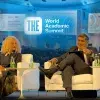The goal of Tec de Monterrey’s Metropolitan Urban Information System (SIUM) is to show the impact of urban expansion in the Monterrey Metropolitan Area by means of a platform promoting the transformation of cities.
Its purpose is to promote strategic, balanced decisions that have an impact on generating a better quality of life in the area.
This describes the Monterrey urbanization process by analyzing its dynamics, causes, and effects, in addition to demographic changes, mobility, public spending, and quality of life.
“Here at the Tec, we’re convinced of the importance of cities, so we decided that we should not simply be spectators but catalysts in their transformation, hence the importance of this project.
“This system will enable us to re-imagine cities and turn them into sustainable, innovative, more human spaces,” explained Juan Pablo Murra, the Tec’s Rector for Higher Education.

Promoted by the Center for the Future of Cities and the FEMSA Foundation, this tool was presented in the Rector’s Building on the Monterrey campus on April 24.
“The creation of SIUM is going to enable us to change the way we think as a society, help us understand where we come from and where we’re going, and catalyze projects and policies that benefit us all.
“It’s a tool that generates environment-transforming dialogue and services. To this end, we need to collaborate with academia, industry, and government,” said Lorena Guillé, Director of the FEMSA Foundation.
“This system will enable us to re-imagine cities and turn them into sustainable, innovative spaces.” - Juan Pablo Murra
Presenting a Platform with Interactive Maps
By 2020, the population of Monterrey’s Metropolitan Area was 5.3 million, which has meant challenges in urban and environmental issues, emphasized Roberto Ponce, leader of the SIUM project.
“We have three very powerful tools that can help us manage the future of cities: infrastructure works, land use, and the economy.
“What we have to do with them is to define a joint vision with the same goal in mind; with SIUM, we aim to have a clear idea of the kind of city we want to become,” he said.
This tool is designed for public officials, civil society organizations, communities, and citizens.
The platform provides a variety of interactive maps of the Monterrey Metropolitan Area where users can consult different data, which are divided into 10 main categories:
- What direction is city growth taking?
- Why are we growing?
- Where do we work?
- How do we get around?
- Why limit child development?
- Why segregate?
- Why is insecurity on the rise?
- Why is it so expensive?
- Why is the temperature so high?
- What will happen if we don’t make changes?

“The creation of SIUM is going to enable us to change our way of thinking as a society.” - Lorena Guillé
Discussing the Future of Cities
A panel entitled Building a Collective Vision: From Expansion to Sustainability was held during the launch of the platform, which was moderated by José Antonio Torre, Director of the Center for the Future of Cities.
“What we’re presenting today is the product of applied multidisciplinary research. We trust that this platform will support the authorities and the community to improve our environments and their future,” remarked José Antonio Torre.

The event was attended by Iraís Bermea, Manager of Communication and Social Impact at the FEMSA Foundation; Sandrine Molinard, Director of the Civic Council; and Edgar Olaiz, Director of Monterrey’s Municipal Institute of Urban Planning and Coexistence.
Also in attendance were Enrique Szendro, who is in charge of the office of the Undersecretary of Territorial Planning and Public Space of the Government of Nuevo León, and Ana Fernanda Hierro, technical secretary of the Nuevo León Council.
YOU MIGHT BE INTERESTED IN:





